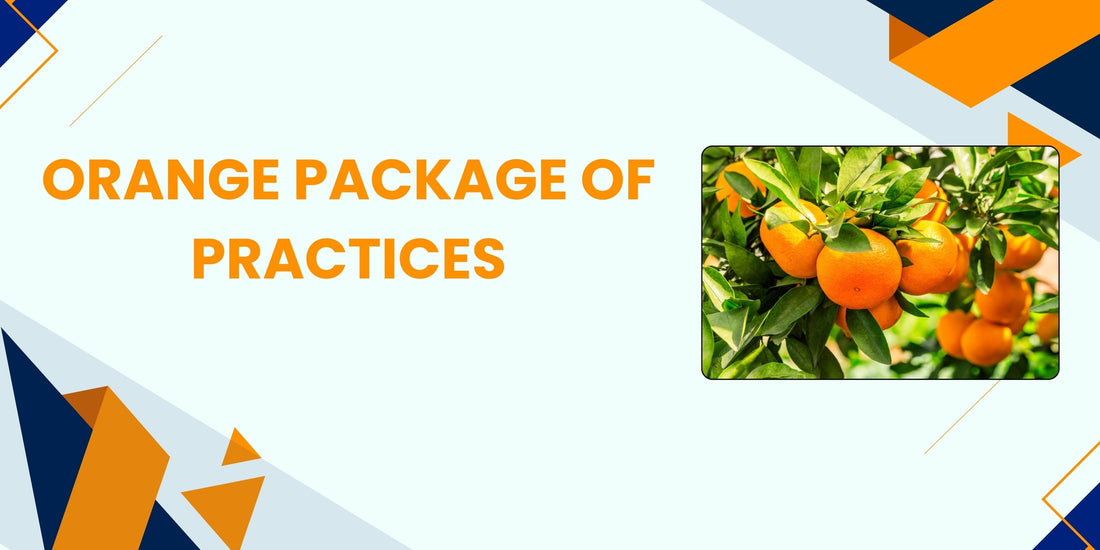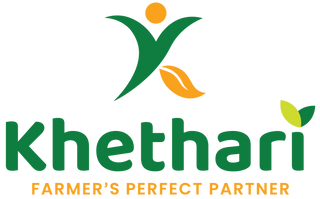
ORANGE PACKAGE OF PRACTICES
Scientific name: Citrus sinensis
Common name: Narinja
Introduction:
Orange farming, also known as citrus cultivation, involves the cultivation of orange trees, which are medium-sized evergreen trees that can reach heights between 6 to 30 feet. These trees are characterized by their glossy, dark green leaves and clusters of fragrant white flowers. The oranges produced are typically round or oval, featuring thick, textured skins that vary in shades of orange.
This agricultural practice is not only popular but also profitable due to the high nutritional value of oranges, which are celebrated for their sweet-tangy flavor and vibrant color. The cultivation of oranges plays a significant role in the global agricultural economy.
Soil and climate:
Sweet orange heavy soils grow best on deep, well-drained loamy soils; otherwise, they provide good crops but are challenging to cultivate. The EC of water should be less than 1.0 and the pH of the soil should be between 6.5 and 7.5. Plants are extremely sensitive to soils that are wet.
A dry climate with about 50-75 cm of rainfall from June-September and with well defined summer and winter season is ideal. Sweet orange can be grown even upto an elevation of 900 m above mean sea level. The extreme of temperature are necessary for achieving higher yield. Temperature 25 ℃ is most ideal and extreme cold and high temperatures are determinate.
Season:
The ideal season for cultivation of sweet orange is July to September.
Planting material:
Budded plants are the best planting materials. (Root Stock - Rangpur lime and rough lemon is mostly preferred).
Land preparation:
Dig pits at 75 cm x 75 cm x 75 cm size at 7 x 7 m spacing. Fill up the pits with top soil and 10 kg of FYM. Plant the budded plants in the centre of the pits and stake it.
Irrigation:
Immediately after planting irrigate copiously. Irrigations may be given once in 10 days. Avoid water stagnation near the plant during monsoon and cyclone periods.
Manure and Fertilizers per plant:
Nitrogen has to be applied in two doses during March and October. However Farm yard manure, Phosphorous and Potash are to be applied in October.
|
Manures and Fertilizers |
I year (kg) |
Annual increase (kg) |
From 6th year (kg) |
|
FYM |
10.000 |
5.000 |
30.000 |
|
N |
0.200 |
0.100 |
0.600 |
|
P2O5 |
0.100 |
0.025 |
0.200 |
|
K2O |
0.100 |
0.040 |
0.300 |
Manures are applied in the basin 70 cm away from the trunk and incorporated in the soil. Spray solution containing Sulphate of Zinc (0.5%), Manganese (0.05%), Iron (0.25%), Magnesium (0.5%), Boron (0.1%) and Molybdenum (0.003%) once in 3 months at the time of new flush production. In addition to that apply 50 g in each of Sulphate of Zinc, Manganese and Iron per tree per year.
Propagation Techniques:
- Although oranges can be grown from seed, budded or grafted (vegetative propagation), seedlings are preferred as planting materials.
- The budding on grafting union should be at least 30cm from the ground to avoid disease infection in the field.
- Propagation by seed takes a long time to produce fruits while vegetatively propagated seedlings take about 2 to 3 years.
- Vegetatively propagated materials can be obtained from government or private commercial nurseries.
- The land should be ploughed up to medium tilth and leveled if necessary.
- All perennial grasses such as couch grass should be cleared and burnt or sprayed beforehand using round-up or glyphogun.
Layout & Spacing:
- It is important that the trees are aligned straight in the row and across rows.
- This necessitates proper layout of the field using pegs, string and tape measure.
- Dig holes 60x60x60cm with spacing of 3.3×3.3m.
- For each hole, the top soil should be separated from the red subsoil.
- It is advisable to plant at the beginning of the rains.
- Remove the polythene sleeves and place the seedlings in the center of the dug holes.
- Cover with soil up to the original level of the nursery sleeve but ensure that the graft joint/budded area is kept well above ground to avoid infection.
- A stake can be planted alongside the seedling to which the seedling is tied to keep it erect.
- Regular and adequate watering should be provided, all the way up to fruiting, depending on weather conditions.
- Then a cover crop of beans or groundnuts should be planted during the first 3 years until the tree canopies have closed in.
- After the trees are fully grown, leave it as a mono-crop.
- Citrus is easily affected by root rot as other intercrops are being cultivated.
-
Avoid planting the cover crop very close to the orange stalk.
Pruning and Training:
In order to allow the growth of a strong trunk, initially shoots upto 40-50 cm from the ground level should be removed. The centre of the plant should remain open. Branches should be well distributed to all sides. Cross twigs and water suckers are to be removed early. The bearing trees require little or no pruning. All diseased, injured and drooping branches and dead wood are to be removed periodically.
Control of Fruit drop:
Early and pre-harvest fruit drop is common in citrus fruits. To control this physiological disorder, it is a better to give three sprays of 2,4-D at 10 ppm (1g/100ℓ), one at the time of flowering, the second one month after fruit set and the third one month before harvest which is beneficial and increases the yield considerably minimizing the fruit drop.
Bahar Treatment:
There are three flushes Ambe bahar (Dec-Jan), Mrig Bahar (June-July), Hastha Bahar (Sept-Oct) in sweet orange. The Hastha Bahar crop comes to harvest in summer and gets renumerative price. Stress period of 20-25 days is sufficient for induction of flowering under Andhra Pradesh conditions. Main season of Bahar is August-September which comes to fruiting in March which is having very good market price.The second season practiced for Bahar is Nov-Dec where fruits comes to harvest in the months of July- august.
Intercropping:
Legumes and vegetable crops can be raised as intercrop during pre-bearing age to get additional income.
Harvesting and Yield:
Yield of the crop commences from 5th year with 40 - 50 fruits per tree & stabilises around the 8th year.Average production is about 500 - 600 fruits per tree after stabilisation.
Post harvest management:
Sweet oranges can be stored at 7 - 8°C with 85 - 90% RH for 4 - 8 weeks.
Sweet oranges may be treated with ethylene gas for de-greening and development of colour. A temperature of 6-7°C, 5-10 ppm of ethylene and 90- 95% RH in a de-greening chamber can set a change in colour in about 48 hours.
